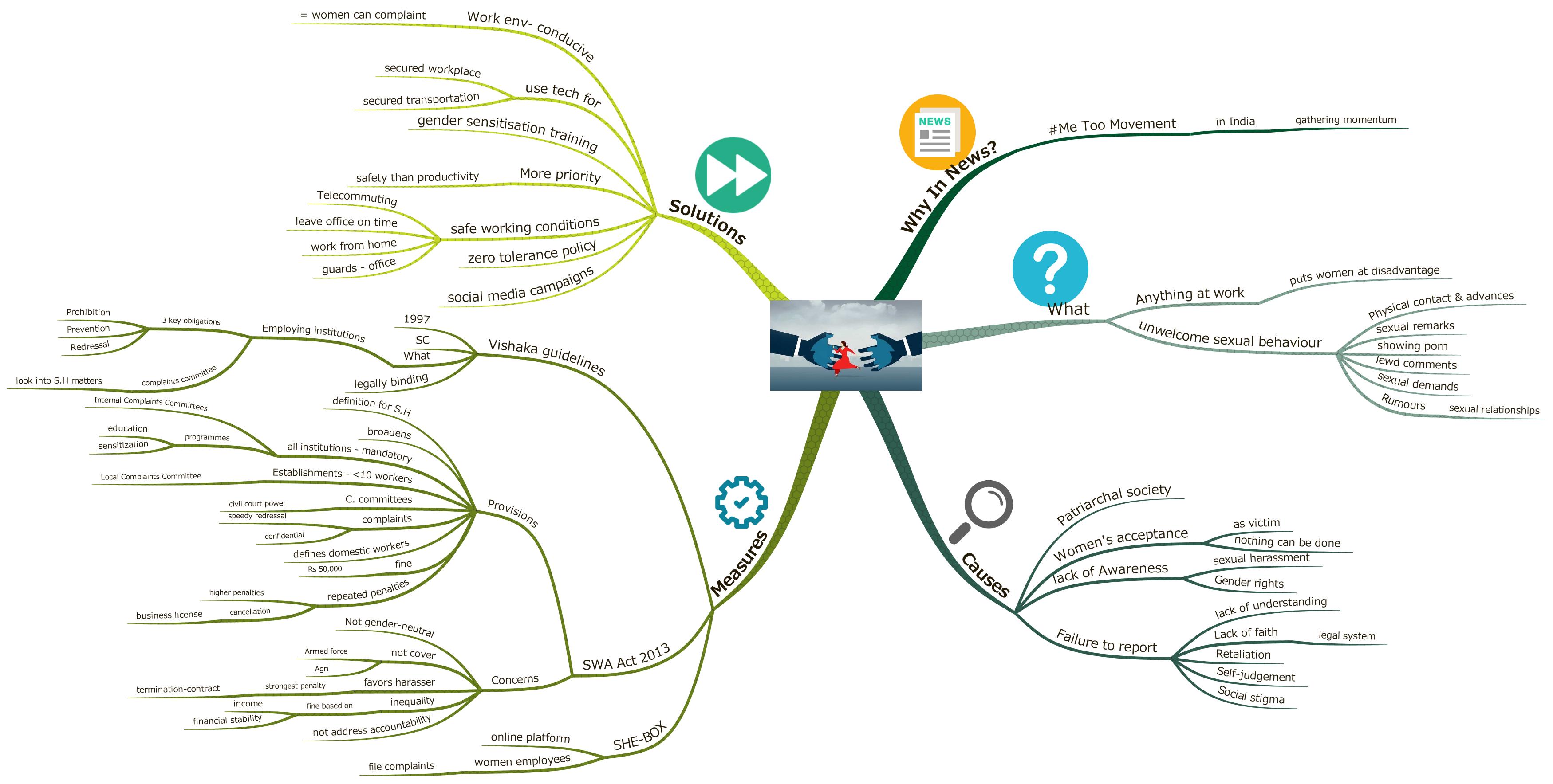Sexual Harassment of Women at Workplace – The Me Too Movement

The #MeToo movement is gathering momentum in India in recent days, with women calling out influential men for alleged sexual harassment. In light of this, it is imperative to analyze everything about sexual harassment in the workplace viz- what, why, initiatives, challenges, and solutions.
This topic of “Sexual Harassment of Women at Workplace – The Me Too Movement” is important from the perspective of the UPSC IAS Examination, which falls under General Studies Portion.
What is Me Too Movement?
- The ‘MeToo’ movement was started in 2006 by Tarana Burke.
- It was to help survivors of sexual violence, by establishing a community of survivors who move forward together.
- The #MeToo spread virally as a hashtag used on social media in an initiative to highlight the widespread prevalence of sexual harassment in the workplace.
- In 2017, it started gaining national attention in the U.S., after allegations about sexual assault by Hollywood producer Harvey Weinstein surfaced.
- In recent weeks, it has gained momentum in India as well.
- As women increasingly speak up on harassment experiences, the general criticism is about the delay in the reporting.
- It has to be noted that the dominant status of men in workplaces i.e., power and privilege, the very lack of understanding on what constitutes sexual harassment, the social stigma associated with the instances, the lack of trust on people to share this, the lack of awareness on legal options available and above all the emotional trauma out of the incident are silencing women from opening out.
- Hence #MeToo movement is a significant initiative for women to speak out about their sexual harassment experience.
What is sexual harassment? (As defined by the court)
- Anything at work that can place the working woman at disadvantage compared to other male employees in her official career just because she is a woman can be termed as sexual harassment.
- Unwelcome sexually motivated behavior and demands from male employees at the workplace like
- Any physical contact as well as advances
- Sexually determined remarks
- Showing pornography
- Passing lewd comments or gestures
- Sexual demands by any means
- Any rumors or talk at the workplace with sexually determined remarks about a working woman or
- Spreading rumors about a woman’s sexual relationship with anybody.
What are the causes of sexual harassment at a workplace?
- Patriarchal society: Sexual harassment is the expression of male power over women and is closely linked to male attitudes about the proper role of a MAN in the society. The perception of men about masculinity is being a good provider of his family is strong. Hence, the feminist drive for economic equality is seen as a threat to their conventional role and thus takes the form of sexual harassment, may be a tool of self-protection.
- Women’s acceptance: Women have accepted themselves as the universal victim of sexual harassment acts like lewd remarks, touching, wolf-whistles etc. and are hence hesitant to take any action against it due to the fear of being ridiculed.
- Awareness: Lack of awareness about the issue of sexual harassment and gender rights in the workplace.
- Failure to report sexual harassments.
Also read: Adultery Law in India (Section 497) – Morality Vs Infidelity
Why most women don’t report sexual harassment?
- Lack of understanding: Most women think that the behavior is not serious enough for them to report or complain as there is a lack of understanding of what harassment is, the laws covering women safety and what they imply.
- Lack of faith: Women don’t have faith in the complaints process as registering a complaint can be embarrassing and the complaint process seem difficult and useless.
- Fear of retaliation: The fear of retaliation by the harasser or organization also makes them silent about it.
- Self-judgement: Some women believe that they can take care of the situation themselves instead of going through the entire complaints redressal procedure.
- Social stigma: There is a stigma associated with sexual harassment in Indian society. Most of the time women are looked down upon if they report such a case, irrespective of who is at fault in that situation. There are several instances of shaming at social media of women who report sexual abuse have been observed.
What are the measures taken?
Vishaka guidelines:
- The Vishaka guidelines were provided by the Supreme Court in Vishaka and others Vs State of Rajasthan judgement in 1997.
- It imposes 3 key obligations on employing institutions including prohibition, prevention, and redress.
- The institutions are also mandated to set up a complaints committee to look into matters of sexual harassment of women at the workplace.
- These guidelines are legally binding.
Sexual Harassment of Women at Workplace (Prevention, Prohibition and Redressal) Act, 2013
- It broadens the Vishaka guidelines which were already in place.
- Sexual harassment includes any one or more unwelcome acts or behavior like physical contact and advances, a demand or request for sexual favors or making sexually colored remarks or showing pornography. The act whether directly, or implication, include any other unwelcome physical, the verbal or non-verbal conduct of sexual nature.
- The act makes it mandatory that all offices, hospitals, institutions and other workplaces should have internal redressal mechanism for complaints related to sexual harassment.
- Every employer is required to establish an Internal Complaints Committee (ICC).
- For establishments which employ less than ten workers, the act provides for establishment of a 5 member Local Complaints Committee (LCC).
- The Complaints Committees have the powers of civil courts for gathering evidence.
- The complaints committees are required to provide for conciliation before initiating an inquiry if requested by the complainant.
- It requires time-bound redressal of complaints which should be confidential.
- It also requires employers to conduct education & sensitization programmes and provide a safe working environment.
- The Act defines a domestic worker as a woman employed to do household work in any household for remuneration whether in cash or kind, either directly or through any agency on a temporary, permanent, part-time or full-time basis, but does not include any member of the family of the employer.
- Those who do not comply with the provisions will be fined up to Rs 50,000.
- The repeated violation would invite higher penalties and cancellation of license or registration to conduct business.
- The act does not cover members of the armed forces including Women.
Concerns with the Act
- It is not a gender-neutral legislation since it protects only women from sexual harassment at workplace.
- The Act does not cover the members of the Armed forces and agricultural workers who form the majority of the workforce.
- The implementation of the Act remains heavily skewed in favor of the harasser. In many cases, the strongest penalty that the molester may face is the termination of his contract.
- The harasser’s next employer will probably have no clue about his record. Also, there is little data on the number of cases that have eventually reached the district officer for the penal action to be initiated against the harasser.
- The penalty is a monetary fine which is paid by the harassers based on their income and financial stability. Thus the Act supports inequality among various sections of society. For instance, a person earning low income would be paying a lower fine compared to a senior who earns more.
- The Act does not satisfactorily address accountability. It does not specify who is in charge of ensuring that workplaces comply with the Act.
- Moreover, as Justice verma committee noted, the law would be counter-productive since dealing with such complaints inside the organization could discourage women from filing complaints.
Sexual Harassment Electronic-Box (SHE-BOX)
- It is an online platform launched by the government to facilitate women employees to file complaints with respect to sexual harassment at the workplace.
- It seeks to ensure effective implementation of the SHW Act, 2013.
- Once a complaint is submitted to the portal, it will be directly sent to the ICC of the concerned Ministry or department.
- It will provide an effective and faster remedy to women facing sexual harassment at workplace since both the Women and Child Development Ministry, as well as complainant, can track the progress or inquiry.
What more could be done?
- Employment Tribunal: Instead of Internet Complaints Committee, there should be an employment tribunal to receive and adjudicate all complaints. This was recommended by the Justice Verma Committee but was not incorporated into the law.
- Getting women to speak up: The organization should make the environment conducive enough for women to register complaints against any sexual harassment. The registered complaints in severe cases transferred to the government should be fast-tracked.
- Utilizing technology: Technology like GPS, CCTV cameras, mobile apps etc. should be used to create secure workplace and transportation to women employees.
- Gender sensitization training: Organisations should conduct gender-sensitization training and awareness programmes for both men and women across their operations.
- Making safety a priority: Organisation often focus on productivity rather than the safety which gives a wrong signal to employees. The top management should try to make safety a priority.
- Creating safe working conditions: With a growing economy, working multiple shifts and late hours at the office are quite common. The increasing crimes against women restrict their capabilities. Hence, an organization should give women options like telecommuting, leaving the office on time and catching up on unfinished work at home. Female security guards can be posted at necessary points in offices and a basic pantry inside the office premises can be provided so that women employees don’t need to go out for dinner when working late.
- Zero tolerance policy should be adopted within the code of conduct for employees to highlight companies’ firmness against any sexual harassment.
- Campaigns like #MeToo and #TimeUp have helped more and more women to speak up about their experiences of abuse. The government should also promote them officially so that more women can come forward to use those campaigns to report and get justice.
What is the way forward?
It is apparent that a written law is not sufficient to give a safer environment for women at the workplace. The problem of sexual harassment requires understanding, assessment, sensitivity as well as commitment from all quarters but mostly from the senior managerial authority. Their commitment and action can accomplish the aim of prevention and effective resolution of sexual harassment at workplace. The patriarchal mindset of people has to be changed to rescue women from the atmosphere of threat, terror, and reprisal.
Practice question:
- Social Media campaigns like Metoo movement highlights the issue of sexual harassment, among many others. Critically analyse the concerns with the India’s sexual harassment laws and what needs to be done?



superb sir thank you for your valuable affort
You’re welcome. And thanks for the positive feedback ?